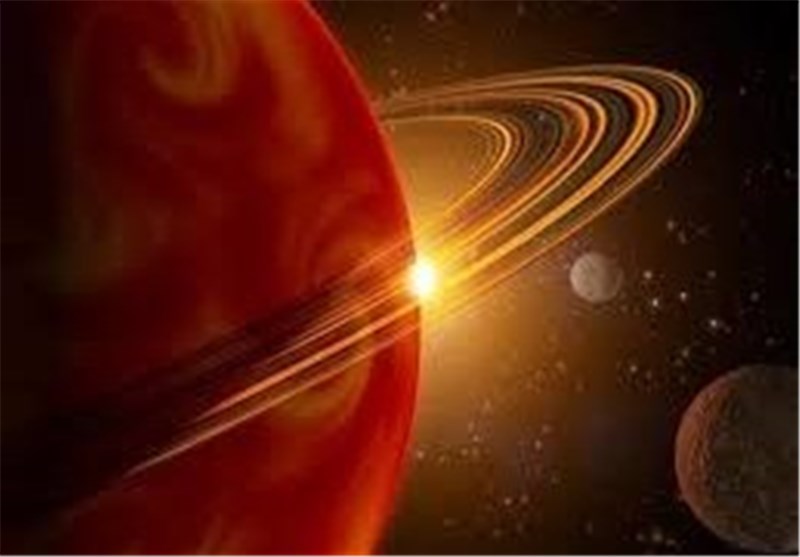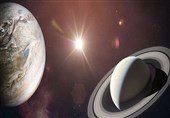Saturn’s Distinctive Look May Be Rooted in Death of An Ancient Moon
TEHRAN (Tasnim) – Saturn may owe its sweeping ring system and distinctive tilt to the death of an ancient moon named Chrysalis, according to the results of a new study.
The gas giant Saturn is one of the most spectacular sights in our solar system. However, despite having been the target of multiple ambitious missions in the past, significant questions remain as to how the iconic planet gained its impressive ring system, and exactly why it orbits on a 26.7 degree tilt relative to its orbital plane.
Astronomers have believed for a while that Saturn’s jaunty angle was the result of a gravitational interplay between the gas giant, its 83 moons, and the tug exerted on it by the planet Neptune. The relationship with the latter was drawn when astronomers realized that Saturn’s spinning top-like motion matched extremely well with the orbital cadence of Neptune.
In other words, the two massive planets were thought to share a strong gravitational association - also known as a resonance.
Data collected by the Cassini spacecraft, which explored the Saturnian system between June 2004 - September 2017, further informed the relationship, by revealing that the massive moon Titan was moving away from Saturn at a surprising speed of 11 cm per year.
This led some scientists to suggest that the gravitational influence and outward movement of this natural satellite - which is significantly larger than Earth’s moon - was likely responsible for maintaining the orbital resonance between Saturn and Neptune.
However, this theory was predicated on one major, and largely undefined characteristic of Saturn - its ‘moment of inertia’. This is essentially the term used to describe the distribution of mass within a heavenly body.
The moment of inertia is an important factor for astronomers looking to understand the orbital properties of a world, as the distribution and density of mass in a planet’s interior can have a significant bearing on its tilt. Therefore if scientists don’t have a good understanding of the moment of inertia, it becomes more difficult to accurately figure out what the history of that planet when, for example, using computer modelling.
Cassini's Legacy
Now, a team of researchers have now used Cassini data from the final part of its mission - known as the ‘Grand Finale’ - to refine Saturn’s moment of inertia, and discovered that it lies outside of the range needed to maintain an orbital resonance with Neptune.
During the ‘Grand Finale’, Cassini was directed to undertake a series of daring dives between Saturn’s cloud surface and its innermost rings. A total of 22 dives were made, during which the spacecraft collected data on Saturn’s internal structure, and the distribution of mass therein.
The team used computer modelling to create a map of the mass distribution of Saturn that fit with Cassini’s real world gravitational measurements. Whilst it was close, the team’s findings revealed that Titan’s pull is not sufficient to maintain the gravitational resonance between Saturn and Neptune. However, judging by Saturn’s present day tilt, the team believes that there was a resonance that lasted for billions of years in the past, that was subsequently broken.
To unravel the mystery, the team began to run computer simulations that essentially turned back the clock on Saturn’s planetary evolution in an attempt to discover gravitational instabilities that could account for the break with Neptune.
After running numerous simulations, the team came to the conclusion that Saturn once hosted at least one more major satellite roughly the size of the moon Iapetus, which has a current day diameter of 457 miles (736 km).
The Death of a Moon
According to the results of the study, published in the journal Science, the gravitational influence of this long dead moon would have maintained the fragile resonance between Saturn and Neptune. Over the course of several billion years, this gravitational dance between the gas giants and moons would have slowly tugged Saturn’s axis onto an extreme tilt.
However, the relationship was not to last. The team estimate that, roughly 160 million years ago, the moon ran afoul of the gravitational influence of its siblings Titan and Iapetus, and was forced ever closer towards the surface of Saturn.
Eventually, Chrysalis would have been shredded by the vast forces being exerted upon it. The vast bulk of the moon’s mass would have disappeared beneath the cloud surface of Saturn. However, a small quantity would escape that fate, and eventually settle around the equator.
With the moon destroyed, the finely balanced resonance was broken, leaving Saturn with its distinctive orbital tilt, and the makings of the fantastic ring system that we see today.






